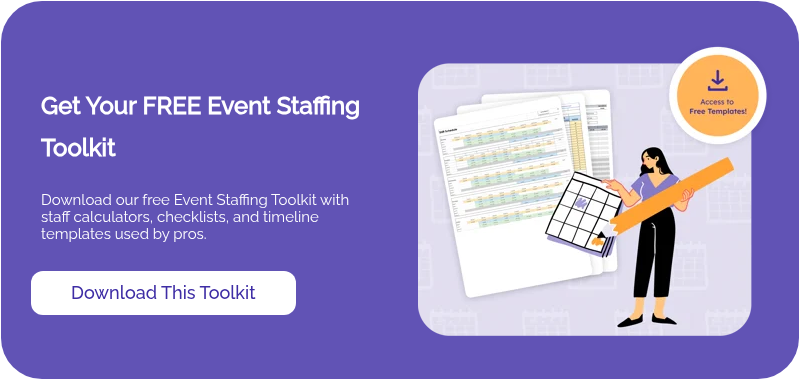Corporate events can be a double-edged sword. Even though they can bring a lot of value to your business, they can occasionally be huge time sinks, cost a fortune (both to attend and host), and determining their ROI immediately is often not straightforward.
However, if you manage to hit the ground running and meet your goals at these events, the miles and minutes you invest can pay off in spades. The secret is to view them as more than just sessions in stuffy conference rooms; instead, you’ll get the most out of these events if you see them as opportunities to strengthen ties with existing clients, make new business connections, and foster relationships with industry media.
Why does event ROI cause so much confusion and doubt among planners and executives? How can you bring events into the digital age while still delivering unique and significant experiences for customers and prospects? Most critically, how can you better plan, execute, and track event value?
Definition of ROI
In general terms, ROI stands for return on investment — a measure of profitability used to determine if an investment in your business is efficient. It takes into account the profits or losses of an investment in comparison to its initial cost. Calculating the ROI will help you determine how much benefit or profit you may get in exchange for an investment of your time, money, or resources.
From an event perspective, ROI refers to the net value that an event organizer obtains from their event in comparison to the net cost incurred to produce it. While the development of technology has made it easier than ever to track customer behavior through digital channels, traditional channels, such as events, are considerably more challenging to track. Beyond the revenue generated from an event, other outcomes such as positive earned media, word-of-mouth, future sales, and stakeholder engagement, should be considered in the ROI equation.
The Importance of Measuring Event ROI
A lot of resources and time go into organizing an event, so keeping track of event success is of the utmost importance. Here’s why tracking event ROI is crucial.
Justification of Costs: You want to give stakeholders and budget holders clear evidence of the worth of every dollar spent. In doing so, you can illustrate how the investment transforms into tangible benefits, thereby reinforcing trust and support for future events.
Strategic Planning: Event ROI gives you a clear picture of what hit the mark and what was missed. This way, you can avoid past mistakes and focus on strategies that actually deliver. You might even be able to make on-the-spot adjustments to improve attendee experiences, such as reallocating resources to popular sessions or quickly addressing logistical issues.
Resource Allocation: Understanding past ROI can inform decisions about staffing levels, technological investments, and logistical arrangements. For example, if data shows that certain types of events or sessions yield higher engagement and conversion rates, you can redirect more personnel to those areas.
Managing your event staff with a tool like Workstaff, allows you to operate at lightning speed, saving you hours in planning, scheduling, and executing. All you need to do is publish temp and flexible staffing requirements, and you will immediately be able to gather and book interested candidates.
Performance Benchmarking: Performance benchmarking involves setting standards based on detailed ROI comparisons across different events, including both quantitative and qualitative metrics, like cost per lead, customer acquisition costs, attendee satisfaction scores, and social media sentiment analysis. By establishing a comprehensive set of benchmarks, you can not only create a multi-dimensional view of event performance but also set more precise and challenging goals for future events.
Stakeholder Satisfaction: By providing stakeholders with a clear and detailed breakdown of both direct and indirect benefits of the event, including positive earned media and word-of-mouth marketing, you show that the investment goes beyond immediate costs and reaches into future revenue and strategic gains. Ultimately, you want to build trust to show stakeholders that every dollar spent contributes to long-term success.
Common Misconceptions About Event ROI
Many stakeholders equate event success solely with immediate financial returns, such as ticket sales or direct revenue generated during the event. This narrow focus overlooks broader and often more significant long-term benefits, such as brand exposure, lead generation, and relationship building, which contribute to overall ROI.
As you start computing your event ROI, be wary of these misconceptions:
Focusing Solely on Financial Metrics: While monetary gains are undeniably powerful, they represent just one chapter in the larger narrative of event success. Non-financial benefits such as brand exposure and attendee satisfaction are equally as significant in contributing to the ROI.
Ignoring Long-term Benefits: While the immediate ROI may be calculated based on sales generated during the event, the valuable impact also lies in the long-term relationships formed with potential clients, industry partners, and media contacts. These relationships can lead to future business opportunities, collaborations, and brand advocacy, contributing significantly to overall ROI.
Overlooking Qualitative Data: While numbers like revenue generated and cost-per-lead are crucial for gauging event success, they only tell part of the story. Qualitative feedback, such as attendee satisfaction, brand sentiment, and overall experience, provides valuable insights that you can't get from numbers alone.
Key Metrics to Measure
No two events are created equal, but growth-focused event marketing teams should quickly gauge event marketing ROI from one event to the next regardless of format. To determine success, however, you must first choose the appropriate metrics that track your progress in achieving your event goals. Here are some common metrics to get you started.
Even though these metrics often overlap and may differ based on the event type, they can be grouped into pre-, during, and post-event evaluations.
Pre-Event Metrics:
Brand Impressions
This refers to the value of media coverage, citations, or mentions of your brand across different channels. These channels include print media, digital outlets, television, social networks, radio, podcasts, and on-site press interviews. More coverage and visibility for your brand ideally translates to greater awareness among your target customers.
Social impressions
Social media is an absolute goldmine for performance indicators, so you will want to encourage as much engagement as possible leading up to the event. Marketers know that social media is a great way to attract attention, promote brand awareness, and create buzz for your event. Fortunately, social media metrics can be tracked via an array of technologies, some even free. By monitoring social engagement related to your event, you have an opportunity to respond, answer questions, or thank attendees.
While social media activity may look impressive on the surface, it doesn't always translate into meaningful outcomes, such as conversions or sales; this is one of the reasons it has been cited often as a vanity metric. You want to properly engage with social media analytics to observe the true impact on your brand and event ROI.
Ticket Sales
Tracking key performance indicators (KPI) should start before your event even happens. One of the first things you will want to measure for any paid event is ticket sales. Do not just focus on the overall numbers, dig a little deeper and track tickets by type if possible, such as early bird sales, VIP sales, and general admission. Having these numbers at your disposal will help you see if early bird sales impacted regular ticket sales and whether or not VIP tickets were an attractive option or a waste of your efforts. It is also worth tracking where the ticket sales are coming from. If you know which marketing channels are generating the most sales, you can focus your marketing strategy accordingly.
During-Event Metrics:
Attendance Rate
Not everyone who registers will show up – this is often referred to as ‘attrition’. However, if you see a big difference between ticket sales and actual event check-in/attendance, it may signal a problem. This is also an incredibly important metric when it comes to your event budget. If you know your events have a 10% average attrition rate, for example, you can save money by adjusting catering orders at future events.
Sponsor/Exhibitor Engagement
Whether your event features a tiered structure of privileges and benefits to sponsors and exhibitors, or they all make the same investment for equal access to your audience, it’s not cheap.
You can even give sponsors the value they want with tools like:
- Badge scanning, lead capture, and retrieval
- Virtual booths and digital real estate
- Channels for sharing sponsor/exhibitor feedback
Post-Event Metrics:
Lead Generation
An effective lead generation strategy goes beyond simply collecting contact information; it involves establishing impactful connections with leads, especially ones with the potential for long-term significance. Engaging attendees in interactive activities, offering valuable content or resources, and facilitating 1-on-1 conversations with sales reps can help qualify leads and move them further down the sales funnel.
Even the post-event conversion rate of leads into customers or clients should be included in your calculations of the event ROI.
Event Revenue
One of the best ways to understand the revenue generated by your paid event is to set goals in the planning stages. What does success look like for your event or business? Is it a dollar amount or an attendance number? Once you have defined these objectives, you can allocate projected costs and revenues in your budget. Clarifying your goals will give you a clear path forward in planning the event and provide you with clear metrics for outlining your success. When the event is over, you can input the real numbers into the budget and see how you fare. If you see you’re in the black, you’ve had success!
10 Foolproof Ways to Measure Event ROI
Once you have the fundamental metrics of an event, it's time to calculate the ROI.
Very simply, comparing the cost of the event to its outcomes—engagement, leads, opportunities, and brand awareness—will give you your ROI. Still, the procedure for gauging event ROI only requires a few more steps.
1. Set Clear and Measurable Objectives
Your goals should be in writing, and everyone who needs to agree on them—all key stakeholders as well as the event marketing team—should agree on them. Aim for 6-8 goals, 4 at minimum. These should be as concrete as possible; if your team has questions or uncertainty, you should take another pass with clarity in mind.
Your goals might be a compilation of any number of these:
- Increase brand awareness
- Increase sales
- Promote product knowledge
- Customer education
- New product launch
- Lead generation
- Media impressions and press coverage
- Increase website traffic
- Increase social media engagement
- Develop influencers and brand ambassadors
2. Utilize Technology for Data Collection and Analysis
Your CRM, analytics tools, social UI data, and survey platforms are good places to start when measuring your success against the goals you’ve set. You'll want to be mindful of how to assess the validity of your tools, the accuracy of the data they provide, and how they will integrate with your current systems (i.e., some platforms only show data for specific periods or in certain formats).
3. Implement Attendee Surveys and Feedback Mechanisms
Surveys are one of the most effective means of collecting quantitative and qualitative information from participants, partners, and vendors. A combination of open- and closed-ended questions is considered best practice.
Many event organizers nowadays have opted to administer surveys during an event to monitor real-time happenings. For instance, in the event of unexpected needs or crises, open communication channels enable survey respondents to convey urgent information easily to the host organization.
The more you know about attendee preferences — and the more you understand what they hope to get out of an event — the more you can cater the experience to their liking. And the more they enjoy their time, the more likely they are to come back for more next month or next year.
4. Leave Room for Qualitative Feedback
How can you price absolute trust, an unprompted testimonial, a deep understanding of your business value, and a warm introduction to a qualified buyer all in one?
While event surveys and live polls bring in solid aggregated statistics, engaging in direct conversations with prospects and attendees also reveals critical information, helping you take the pulse of attendees, even if only anecdotally. Ask attendees their thoughts from pre-event suggestions to post-event feedback — and reply to them. Entering the dialogue will help them feel engaged and let them know their opinions and experiences matter.
By encouraging participants to provide detailed responses about their event experience, including what they enjoyed, areas for improvement, and suggestions for future events, you can indeed iterate and finetune future events.
5. Incorporating Both Financial and Non-financial Factors
Your event attendees are more than just a number – after all, people use their emotions to govern much of their decisions in life. This remains true when it comes to attending and buying decisions.
In fact, 95% of purchasing decisions made are influenced by emotions and not logic. Thus, the more satisfied your attendees are with your event, the closer you are to achieving your financial target and ROI. Non-financial factors may include positive experiences, valuable networking opportunities, knowledge gained from keynote presentations, media coverage, and social media engagement, all of which work in tandem to build brand exposure and industry visibility.
Finding the right staff is paramount in measuring event ROI by both financial and non-financial factors because the quality and efficiency of your staff directly impact the overall success and attendee experience of your event. But this can often be the biggest headache, especially considering that it's temporary work with specific requirements. The constant need to recruit, schedule, and manage a flexible workforce can be overwhelming for event organizers. So when you’re exploring technologies to streamline event planning, think about tools that can build custom schedules for events, including an offer, booking, and scheduling engine for managing the availability and skills of candidates.
6. Assign Monetary Values to Non-monetary Benefits
Assigning monetary values to non-monetary event benefits isn't just about crunching numbers —you want to recognize the genuine worth of every aspect of your event. When you quantify the value of concepts like brand exposure and networking opportunities, you're painting a vivid picture of the impact your event has beyond just dollars and cents.
So if you want to demonstrate the full scope of your event's influence to the leadership team, here are some techniques to consider:
- Advertising Value Equivalent (AVE): Ever heard the saying, "All publicity is good publicity"? By estimating the cost of equivalent advertising space, you can convert media coverage into monetary value and quantify the reach and impact of your event.
- Social Media Metrics: Depending on the nature of your event, social media may very well be where the action is. Metrics like impressions, engagements, and reach convey the value of social media exposure. Consider the potential reach and engagement of your event-related content and use industry benchmarks or advertising rates to assign a monetary value to social media awareness.
- Partnership Revenue: Don't underestimate the power of partnerships! Be sure to assess potential revenue generated from new partnerships and collaborations formed during your event, including estimations of long-term financial benefits, and factor them into your ROI calculations.
7. Consider the Long-term Impact of the Event
Looking at event metrics immediately following an event, 30 days, 60 days, and 90 days post-event imparts structure and gives you a sense of true ROI after an event.
For many marketers and growth teams, the 30-day mark is usually the first time where they can start to dive into reliable return-on-investment metrics. At this point, the post-event nurture campaigns have been sent, the sales team has kicked off their follow-up process, and everyone has a sense of traction post-event.
Consider using a time marker to reflect with your team on the post-event process—if the pipeline is light, is that because the event wasn’t strong, or could the post-event follow-up process be stronger? The 60-day mark is also a great time for re-engagement from an event, as most people are inundated with follow-ups immediately after an event.
8. Collaborate with Stakeholders to Gather Insights
Everyone – from sponsors to media partners to speakers – brings diverse perspectives and experiences to the table, making for a well-rounded view of the event's strengths, weaknesses, and opportunities. Sit down with these stakeholders and capture insights on all aspects of the event. On many occasions, they may even locate blind spots or areas for improvement that your team may overlook! So, as you collaborate with these stakeholders, keep an eye out for recurring themes in the feedback and focus on tackling the issues that will make the most impact while being realistic about what's doable.
9. Iterate and Improve Based on Data Analysis
Smart event planners and organizers are able to not just examine numbers, but to look deeper and to ask “Why?” instead of just asking “What?” or “How much?”. Using the answers to “Why?” questions to design better experiences in the future is the key to successful event planning.
Once you’ve collected all the data and analyzed it, it’s time to start organizing activities based on that very data. Use all the information about your attendees – their expectations, previous events, and competitors – to help you plan onsite activities, event personalization, promotions, and everything else that you need for an even more successful event in the future.
With staff management software like Workstaff, gathering and analyzing personnel data becomes a breeze, especially with its user-friendly time and attendance tracking features like built-in clock-in/clock-out, automatic reminders, and live presence reporting. Staff can effortlessly log their hours and receive timely reminders, while organizers can keep an eye on attendance in real-time. This valuable data helps spot trends and improve future event planning for an even smoother experience.
10. Communicate Findings and Insights Effectively
Are you using infographics to illustrate key event metrics, success stories to highlight impactful moments, and actionable recommendations?
Whether presenting to executives, sponsors, or internal teams, effective communication of ROI findings is what secures buy-in for future investments. Remember, it's not just about the numbers — it's about conveying the value and impact of your event in a way that resonates and inspires action.
Elevate Your Events With The Right People & Technology
Events can be incredibly effective, but they’re not cheap, and if you’re spending thousands of dollars on bringing together your staff, customers, or prospects, they need to provide real tangible business value. If you can prove event ROI, events can be worth the investment.
However, event ROI measurement isn’t one-size-fits-all. It begins with figuring out which success metrics matter most to you and finding the best time to measure them, which can be trickier than it seems.
Measuring event ROI demands a multifaceted framework, one that blends both quantitative and qualitative methods. It begins with setting clear objectives, followed by leveraging technology for data collection and analysis. Incorporating attendee surveys and feedback mechanisms provides valuable insights into attendee satisfaction and preferences. Assigning monetary values to non-financial benefits and collaborating with stakeholders offers a holistic view of event success. By iteratively improving based on data analysis and effectively communicating findings, event planners can refine strategies and pave the way for more powerful events.
If event ROI is important to you (and it should be!), one of the best areas you can focus on as an event coordinator is staffing. Staffing serves as the backbone of any successful event. Yet, managing temporary staff can be daunting.
Technology solutions like Workstaff simplify the process. Workstaff’s shift scheduling and planning software does everything from coordinating staff to publishing shifts to streamlining invoicing. By optimizing event staffing operations through technology, event organizers can not only improve operational effectiveness but also build up the economics of hiring temporary staff, ultimately leading to increased ROI for their events.
To learn more about our event staff management softwareand how it can help ensure high ROI for your events, book a demo with our team today.











